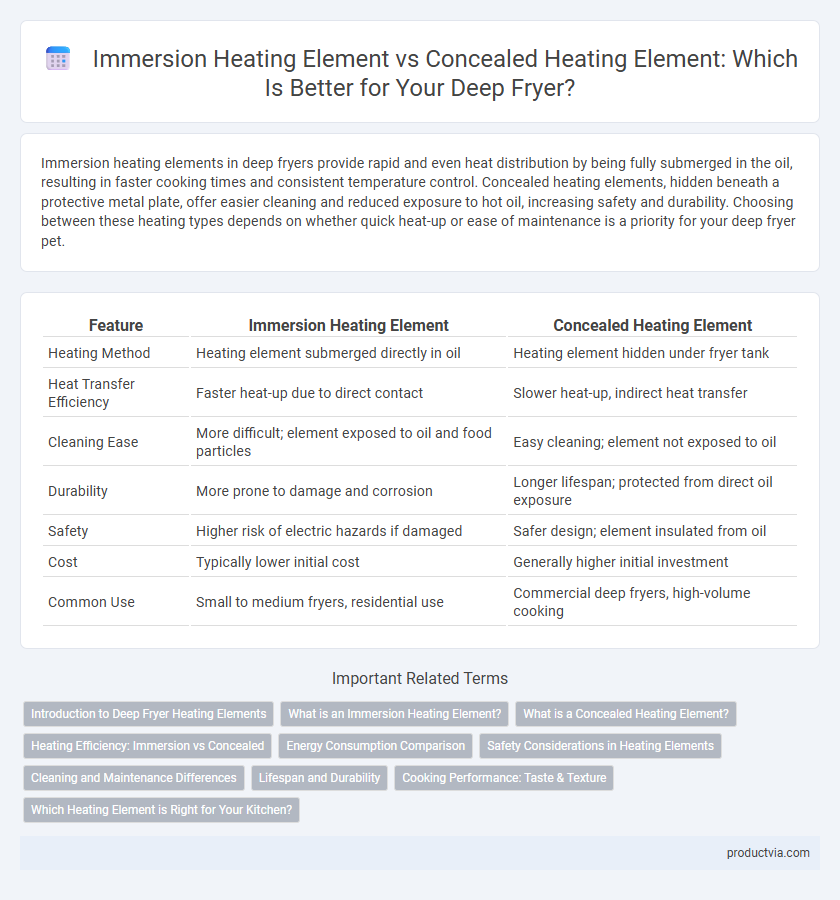Immersion heating elements in deep fryers provide rapid and even heat distribution by being fully submerged in the oil, resulting in faster cooking times and consistent temperature control. Concealed heating elements, hidden beneath a protective metal plate, offer easier cleaning and reduced exposure to hot oil, increasing safety and durability. Choosing between these heating types depends on whether quick heat-up or ease of maintenance is a priority for your deep fryer pet.
Table of Comparison
| Feature | Immersion Heating Element | Concealed Heating Element |
|---|---|---|
| Heating Method | Heating element submerged directly in oil | Heating element hidden under fryer tank |
| Heat Transfer Efficiency | Faster heat-up due to direct contact | Slower heat-up, indirect heat transfer |
| Cleaning Ease | More difficult; element exposed to oil and food particles | Easy cleaning; element not exposed to oil |
| Durability | More prone to damage and corrosion | Longer lifespan; protected from direct oil exposure |
| Safety | Higher risk of electric hazards if damaged | Safer design; element insulated from oil |
| Cost | Typically lower initial cost | Generally higher initial investment |
| Common Use | Small to medium fryers, residential use | Commercial deep fryers, high-volume cooking |
Introduction to Deep Fryer Heating Elements
Deep fryer heating elements are essential for efficient and consistent oil temperature control, with immersion and concealed types being the primary options. Immersion heating elements are directly exposed to the oil, providing rapid heat transfer and quicker oil recovery, ideal for high-volume frying. Concealed heating elements are shielded within the fryer's structure, offering easier cleaning and longer durability by reducing oil contact and buildup.
What is an Immersion Heating Element?
An immersion heating element in a deep fryer is a metal coil or rod directly submerged in the cooking oil, allowing rapid and efficient heat transfer. This design provides faster heat-up times and more consistent temperature control compared to concealed heating elements, which are hidden underneath the fryer's oil container. Immersion heating elements are popular in commercial and home deep fryers for their reliability and energy efficiency during frying processes.
What is a Concealed Heating Element?
A concealed heating element in a deep fryer is integrated within the fryer's body, hidden beneath the oil reservoir to ensure even heat distribution and easier cleaning. Unlike immersion heating elements that are directly exposed to oil, concealed elements reduce the risk of oil buildup and prolong the appliance's lifespan by preventing direct contact with food debris. This design enhances safety and efficiency, making concealed heating elements a preferred choice for both commercial and home deep fryers.
Heating Efficiency: Immersion vs Concealed
Immersion heating elements in deep fryers provide faster and more efficient heat transfer because they are directly submerged in the oil, allowing rapid temperature rise and uniform heat distribution. Concealed heating elements, located beneath or within the fryer's structure, offer easier cleaning and safety but generally exhibit slower heating times and less energy efficiency due to indirect heat transfer. The choice between immersion and concealed heating elements significantly impacts the overall cooking speed, energy consumption, and oil temperature stability in commercial and home deep fryers.
Energy Consumption Comparison
Immersion heating elements in deep fryers directly contact the oil, resulting in faster heating and lower energy consumption compared to concealed heating elements that are insulated from the oil. Concealed heating elements often require longer preheat times and can lead to higher overall electricity usage due to less efficient heat transfer. Energy efficiency studies indicate immersion elements reduce operating costs by up to 20% in commercial frying applications.
Safety Considerations in Heating Elements
Immersion heating elements in deep fryers offer faster heat transfer but expose heating components directly to oil, increasing the risk of electrical hazards and burns if damaged. Concealed heating elements are enclosed within the fryer's metal structure, reducing oil contact and minimizing the chances of oil contamination, leaks, and potential fire hazards. Safety standards often favor concealed elements for home and commercial use due to their enhanced protection against accidental contact and easier cleaning, lowering the risk of oil-related accidents.
Cleaning and Maintenance Differences
Immersion heating elements in deep fryers are directly exposed to oil, making cleaning more labor-intensive as oil residues and food particles can accumulate around the element. Concealed heating elements, hidden beneath the fryer's oil tank, facilitate easier maintenance by preventing direct contact with oil, reducing buildup and simplifying oil changes. This design difference significantly impacts cleaning frequency and effort, with concealed elements offering improved hygiene and operational efficiency.
Lifespan and Durability
Immersion heating elements in deep fryers typically offer quicker heat transfer but are more exposed to oil corrosion, potentially reducing lifespan and durability. Concealed heating elements are enclosed within the fryer body, protecting them from direct oil contact and enhancing resistance to wear, thereby extending the overall lifespan. Durability of concealed heating elements generally ensures lower maintenance costs and longer service intervals in commercial frying equipment.
Cooking Performance: Taste & Texture
Immersion heating elements in deep fryers provide direct contact with oil, resulting in faster heat transfer and more consistent cooking temperatures that enhance the crispiness and even browning of fried foods. Concealed heating elements are protected within the fryer's body, offering easier cleanup and safety but may heat oil less evenly, potentially affecting the texture and taste by causing inconsistent cooking spots. Choosing immersion heating elements generally yields superior taste and texture due to quicker heat recovery and more uniform frying conditions.
Which Heating Element is Right for Your Kitchen?
Immersion heating elements in deep fryers heat oil faster due to direct contact, making them ideal for high-volume kitchens requiring quick recovery times. Concealed heating elements are enclosed and easier to clean, preventing food debris buildup and extending the fryer's lifespan, suitable for environments focused on hygiene and maintenance efficiency. Choosing the right heating element depends on your kitchen's operational speed and cleaning priorities.
Immersion heating element vs concealed heating element for deep fryer Infographic

 productvia.com
productvia.com